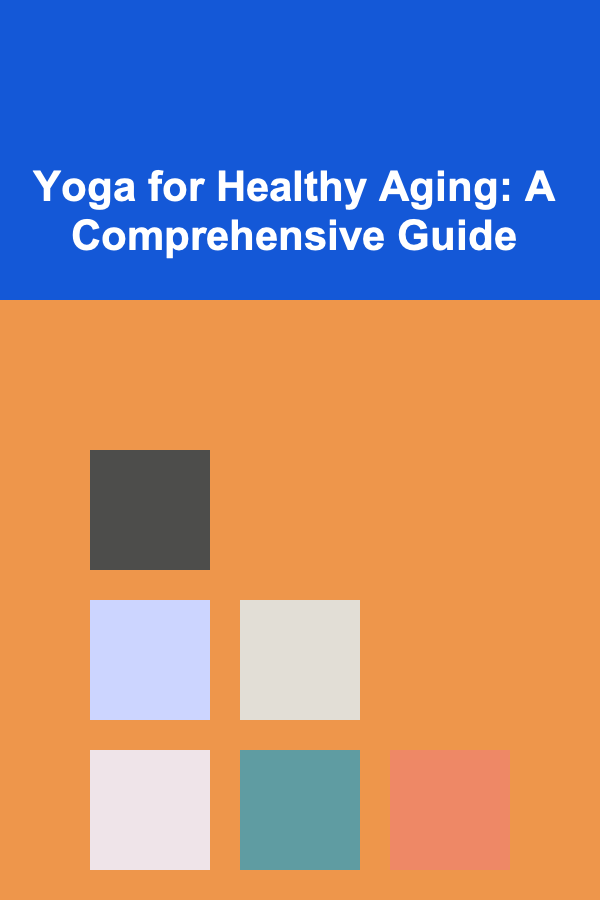
Yoga for Healthy Aging: A Comprehensive Guide
ebook include PDF & Audio bundle (Micro Guide)
$12.99$10.99
Limited Time Offer! Order within the next:

Introduction: The Power of Yoga in Aging Gracefully
As we age, our bodies and minds undergo inevitable changes. These changes, while a natural part of life, can sometimes bring about challenges to our physical and mental well-being. Conditions like reduced mobility, decreased bone density, chronic pain, and cognitive decline are common concerns. However, aging doesn't have to mean a decline in quality of life. Yoga, a practice that integrates physical postures, breathing techniques, and meditation, offers a powerful and holistic approach to promoting healthy aging.
This comprehensive guide delves into the multifaceted benefits of yoga for seniors and individuals seeking to age gracefully. We'll explore how yoga can address specific age-related concerns, provide practical guidance on adapting yoga practices for different needs and abilities, and offer a roadmap for incorporating yoga into a sustainable and enjoyable healthy aging strategy.
Understanding the Aging Process and its Challenges
Before exploring the specific benefits of yoga, it's crucial to understand the common challenges associated with aging. This understanding allows us to appreciate how yoga can be a particularly effective intervention.
- Decreased Mobility and Flexibility: Loss of muscle mass (sarcopenia) and stiffening of joints can limit range of motion, making everyday activities more difficult.
- Bone Density Loss (Osteoporosis): Bones become more brittle and prone to fractures, increasing the risk of falls and injuries.
- Chronic Pain: Conditions like arthritis, back pain, and nerve pain become more prevalent, impacting quality of life and functional ability.
- Cardiovascular Issues: The risk of heart disease, high blood pressure, and stroke increases with age.
- Cognitive Decline: Memory loss, difficulty concentrating, and other cognitive impairments can affect independence and daily functioning.
- Balance Problems: Deterioration of balance can lead to falls, a major cause of injury and disability in older adults.
- Mental and Emotional Well-being: Loneliness, isolation, anxiety, and depression are common challenges that can significantly impact overall health.
The Multifaceted Benefits of Yoga for Healthy Aging
Yoga offers a powerful antidote to many of the challenges associated with aging. Its benefits extend beyond the physical realm, positively impacting mental, emotional, and spiritual well-being.
- Improved Mobility and Flexibility: Yoga postures gently stretch and strengthen muscles, increasing range of motion in joints and improving overall mobility. Regular practice can help combat stiffness and improve ease of movement.
- Increased Bone Density: Weight-bearing yoga poses stimulate bone growth and help to maintain bone density, reducing the risk of osteoporosis and fractures. Certain poses, like tree pose and warrior poses, are particularly beneficial for bone health.
- Pain Management: Yoga can effectively manage chronic pain by reducing inflammation, releasing muscle tension, and improving circulation. Specific poses and breathing techniques can help alleviate pain associated with arthritis, back pain, and other conditions.
- Cardiovascular Health: Yoga lowers blood pressure, reduces heart rate, and improves circulation, contributing to better cardiovascular health. Relaxation techniques, such as deep breathing and meditation, can help reduce stress, a major risk factor for heart disease.
- Enhanced Cognitive Function: Yoga improves blood flow to the brain, enhances focus and concentration, and promotes neuroplasticity, the brain's ability to adapt and change. Studies have shown that yoga can improve memory, attention, and executive function.
- Improved Balance and Coordination: Yoga poses that challenge balance help to strengthen core muscles and improve proprioception (awareness of body position in space), reducing the risk of falls.
- Stress Reduction and Mental Well-being: Yoga promotes relaxation, reduces stress hormones (cortisol), and increases levels of feel-good hormones (endorphins). Meditation and mindfulness practices can help to calm the mind, reduce anxiety, and improve overall mood.
- Social Connection: Participating in yoga classes provides opportunities for social interaction and connection, combating loneliness and isolation. Building relationships with fellow practitioners can contribute to a sense of community and belonging.
Adapting Yoga for Different Needs and Abilities: Safety First
It's crucial to adapt yoga practices to individual needs and abilities, especially for older adults or those with pre-existing health conditions. Prioritizing safety is paramount.
Consultation with Healthcare Professionals
Before starting any new exercise program, including yoga, it's essential to consult with a physician or other healthcare professional. They can assess your individual needs, identify any contraindications (reasons why certain poses may be unsafe), and provide personalized recommendations.
Modifications and Props
Yoga poses can be modified to accommodate limitations in range of motion, strength, or balance. Using props, such as chairs, blocks, straps, and blankets, can provide support, stability, and accessibility.
- Chair Yoga: Chair yoga is a modified form of yoga that can be practiced while seated in a chair or using the chair for support. It's an excellent option for individuals with limited mobility, balance issues, or difficulty getting down to the floor.
- Wall Support: Using a wall for support can provide stability in standing poses, such as tree pose and warrior poses.
- Blocks and Straps: Blocks can help to bring the floor closer to you in poses like triangle pose or forward folds. Straps can extend your reach and allow you to safely perform poses that might otherwise be inaccessible.
Gentle and Slow Movements
Focus on slow, controlled movements and avoid pushing yourself beyond your limits. Listen to your body and stop if you experience any pain or discomfort. Gentle stretching is often more beneficial than forcing yourself into a pose.
Breathing Techniques (Pranayama)
Breathing techniques are an integral part of yoga. Focus on deep, diaphragmatic breathing, which can help to calm the nervous system, reduce stress, and improve lung capacity. Simple techniques like Ujjayi breath (ocean breath) or alternate nostril breathing can be very beneficial.
Qualified Instructors
Seek out qualified yoga instructors who have experience working with older adults or individuals with specific health conditions. A good instructor will be able to assess your needs, provide modifications, and ensure your safety. Look for instructors certified by Yoga Alliance or other reputable organizations.
Recommended Yoga Poses for Healthy Aging
This section provides a selection of yoga poses that are generally considered safe and beneficial for healthy aging. Remember to consult with your doctor and a qualified yoga instructor before starting any new yoga practice.
Standing Poses:
- Mountain Pose (Tadasana): This foundational pose improves posture, strengthens core muscles, and promotes grounding. Stand tall with feet hip-width apart, arms at your sides, and shoulders relaxed. Engage your core and lengthen your spine.
- Tree Pose (Vrksasana): Tree pose improves balance, strengthens legs, and promotes focus. Stand on one leg, placing the sole of your other foot on your inner thigh (avoid the knee joint). Bring your hands to prayer position at your chest or raise them overhead. Use a wall for support if needed.
- Warrior II (Virabhadrasana II): Warrior II strengthens legs, opens hips, and improves stamina. Step one leg forward into a lunge, keeping your front knee bent at a 90-degree angle and aligned over your ankle. Extend your arms out to the sides, parallel to the floor. Turn your head to look over your front hand.
- Triangle Pose (Trikonasana): Triangle pose stretches hamstrings, hips, and spine. Stand with feet wide apart, turn one foot outward, and reach down towards your ankle while extending your opposite arm towards the ceiling. Use a block to support your hand if needed.
Seated Poses:
- Easy Pose (Sukhasana): This simple seated pose promotes relaxation and opens the hips. Sit comfortably on the floor with your legs crossed. Use a cushion or blanket to elevate your hips if needed.
- Staff Pose (Dandasana): Staff pose strengthens back muscles and improves posture. Sit with your legs extended straight out in front of you. Keep your back straight and your core engaged.
- Seated Forward Fold (Paschimottanasana): This pose stretches hamstrings and spine. Sit with your legs extended straight out in front of you and gently fold forward from your hips. Use a strap to reach your feet if needed. Focus on lengthening your spine rather than reaching as far as possible.
- Spinal Twist (Ardha Matsyendrasana): Spinal twists improve flexibility of the spine and stimulate digestion. Sit with your legs extended, bend one knee, and place your foot outside your opposite thigh. Twist your torso towards the bent knee, using your hand for support.
Reclining Poses:
- Bridge Pose (Setu Bandhasana): Bridge pose strengthens back muscles, glutes, and hamstrings. Lie on your back with your knees bent and feet flat on the floor. Lift your hips off the floor, engaging your core and glutes.
- Knees-to-Chest Pose (Apanasana): This pose relieves lower back pain and relaxes the abdominal muscles. Lie on your back and draw your knees towards your chest. Gently rock from side to side to massage your lower back.
- Corpse Pose (Savasana): This restorative pose promotes deep relaxation and stress reduction. Lie on your back with your arms at your sides, palms facing up. Close your eyes and relax your entire body. Focus on your breath and allow yourself to completely surrender.
- Supported Reclining Butterfly (Supta Baddha Konasana): This pose gently opens the hips and groin. Lie on your back and bring the soles of your feet together, allowing your knees to fall open. Use pillows or blankets under your knees for support.
Breathing Techniques (Pranayama) for Calming and Vitality
Pranayama, or yogic breathing techniques, are powerful tools for calming the mind, reducing stress, and increasing energy levels. These techniques are particularly beneficial for healthy aging.
- Diaphragmatic Breathing (Belly Breathing): This simple technique involves breathing deeply from the diaphragm, the large muscle at the base of the lungs. Place one hand on your chest and the other on your belly. As you inhale, your belly should rise while your chest remains relatively still. As you exhale, your belly should fall.
- Ujjayi Breath (Ocean Breath): Ujjayi breath involves gently constricting the back of your throat as you inhale and exhale, creating a soft, ocean-like sound. This technique helps to calm the mind, focus attention, and regulate energy flow.
- Alternate Nostril Breathing (Nadi Shodhana): This technique balances the left and right hemispheres of the brain, promoting relaxation and reducing anxiety. Close one nostril with your finger and inhale through the other nostril. Then, close the other nostril and exhale through the first nostril. Continue alternating nostrils with each breath.
- Cooling Breath (Sitali Pranayama): This technique is excellent for cooling the body and calming the mind, especially during hot weather. Curl your tongue lengthwise and inhale through the curled tongue. Exhale through your nose. If you cannot curl your tongue, simply purse your lips and inhale through the small opening.
Practice these breathing techniques for 5-10 minutes each day to experience their benefits. Find a quiet and comfortable space where you can relax and focus on your breath.
Meditation and Mindfulness for Mental Clarity and Emotional Well-being
Meditation and mindfulness practices cultivate present moment awareness, reduce stress, and promote mental clarity. They are invaluable tools for maintaining emotional well-being throughout the aging process.
- Mindfulness Meditation: Find a comfortable seated position and focus your attention on your breath, bodily sensations, or sounds around you. When your mind wanders, gently redirect your attention back to your chosen focus.
- Walking Meditation: Focus your attention on the sensations of your feet making contact with the ground as you walk. Notice the rhythm of your breath and the movement of your body.
- Loving-Kindness Meditation (Metta Meditation): This practice cultivates feelings of compassion and kindness towards yourself and others. Repeat phrases such as "May I be well, may I be happy, may I be peaceful" while focusing on your own well-being. Then, extend these wishes to others, including loved ones, neutral people, difficult people, and all beings.
- Body Scan Meditation: Lie down comfortably and bring your attention to different parts of your body, starting with your toes and working your way up to your head. Notice any sensations of tension, relaxation, or discomfort.
Start with short meditation sessions of 5-10 minutes and gradually increase the duration as you become more comfortable. Consistency is key to experiencing the benefits of meditation.
Creating a Sustainable Yoga Practice for Healthy Aging
The key to reaping the long-term benefits of yoga is to create a sustainable practice that you can enjoy and maintain over time.
- Start Slowly and Gradually Increase Intensity: Don't try to do too much too soon. Begin with short, gentle yoga sessions and gradually increase the duration and intensity as you become stronger and more flexible.
- Listen to Your Body: Pay attention to your body's signals and stop if you experience any pain or discomfort. Rest when you need to and don't push yourself beyond your limits.
- Find a Qualified Instructor: Working with a qualified yoga instructor can help you to learn proper alignment, modify poses, and stay safe.
- Make it a Habit: Schedule regular yoga sessions into your week, just like you would any other important appointment. Consistency is key to experiencing the benefits of yoga.
- Practice with a Friend or in a Group: Practicing yoga with a friend or in a group can provide motivation, social support, and a sense of community.
- Be Patient and Kind to Yourself: Yoga is a journey, not a destination. Be patient with yourself and celebrate your progress along the way.
Conclusion: Embracing Yoga for a Vibrant and Fulfilling Life
Yoga offers a powerful and holistic approach to healthy aging. By incorporating yoga into your life, you can improve your physical, mental, and emotional well-being, enhance your quality of life, and embrace aging with grace and vitality. Remember to consult with your doctor and a qualified yoga instructor to create a safe and personalized practice that meets your individual needs. Embrace the journey and enjoy the many benefits that yoga has to offer.
As we age, the importance of self-care and proactive health management cannot be overstated. Yoga, with its profound effects on the mind and body, provides a pathway to a more vibrant, fulfilling, and healthy life. It's more than just exercise; it's a holistic practice that empowers individuals to take control of their well-being and navigate the aging process with resilience and joy.

How to Choose Dining Room Accessories That Fit Your Style
Read More
How to Choose the Right Technology for Remote Work
Read More
How to Leverage Deep Learning to Create a Sustainable Passive Income
Read More
Navigating Complex Customer Interactions: Strategies and Tactics for a Career in Customer Service
Read More
How to Meditate to Boost Your Immune System
Read More
10 Tips for Measuring the ROI of Your Leadership Development Planner
Read MoreOther Products

How to Choose Dining Room Accessories That Fit Your Style
Read More
How to Choose the Right Technology for Remote Work
Read More
How to Leverage Deep Learning to Create a Sustainable Passive Income
Read More
Navigating Complex Customer Interactions: Strategies and Tactics for a Career in Customer Service
Read More
How to Meditate to Boost Your Immune System
Read More